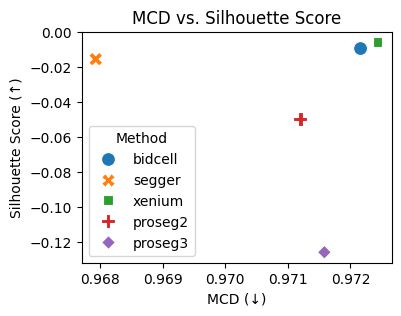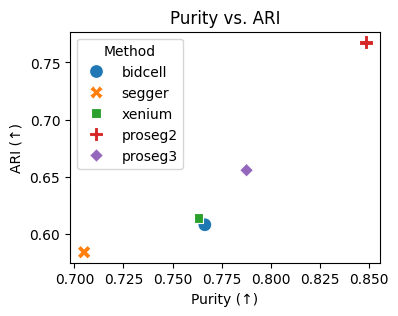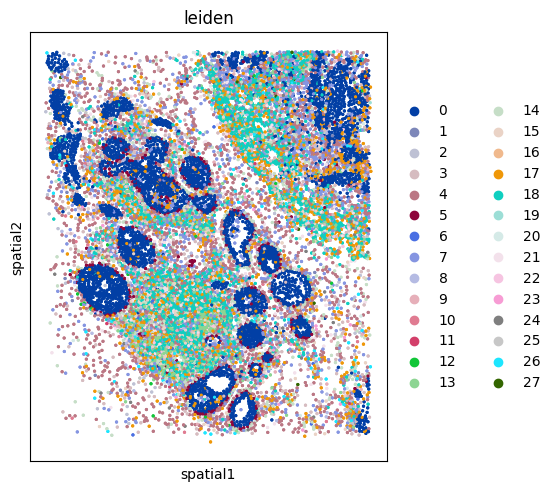Clustering stability#
In spatial transcriptomics, cells are typically clustered into cell types based on their RNA expression. If the segmentation of a spatial transcriptomics dataset went well, we would assume that this clustering is somewhat stable, even if we only cluster on parts of the data. The cs (clustering stability) module includes some functions to apply clustering and assess its robustness.
To follow along with this tutorial, you can download the data from here.
[1]:
%load_ext autoreload
%autoreload 2
import copy
from pathlib import Path
import anndata as ad
import matplotlib.pyplot as plt
import pandas as pd
import scanpy as sc
import seaborn as sns
import spatialdata as sd
import spatialdata_plot # noqa: F401
import squidpy as sq
import segtraq
# example datasets on which we can compare performance
st_bidcell = segtraq.SegTraQ(
sd.read_zarr("../../data/bidcell.zarr"),
images_key="image",
points_background_id=0,
tables_x_key="centroid_x",
tables_y_key="centroid_y",
)
st_segger = segtraq.SegTraQ(
sd.read_zarr("../../data/segger.zarr"),
images_key="image",
tables_x_key="cell_centroid_x",
tables_y_key="cell_centroid_y",
)
st_xenium = segtraq.SegTraQ(
sd.read_zarr("../../data/xenium.zarr"), images_key="image", tables_x_key="x_centroid", tables_y_key="x_centroid"
)
st_proseg2 = segtraq.SegTraQ(
sd.read_zarr("../../data/proseg2.zarr"),
images_key="image",
points_background_id=0,
tables_area_volume_key="volume",
tables_x_key="centroid_x",
tables_y_key="centroid_x",
)
st_proseg3 = segtraq.SegTraQ(
sd.read_zarr("../../data/proseg3.zarr"),
points_cell_id_key="assignment",
points_gene_key="gene",
points_background_id=None,
shapes_cell_id_key="cell",
tables_cell_id_key="cell",
images_key=None,
tables_area_volume_key=None,
nucleus_shapes_key=None,
tables_x_key="centroid_x",
tables_y_key="centroid_x",
)
st_dict = {
"bidcell": st_bidcell,
"segger": st_segger,
"xenium": st_xenium,
"proseg2": st_proseg2,
"proseg3": st_proseg3,
}
/g/huber/users/meyerben/notebooks/spatial_transcriptomics/SegTraQ/.venv/lib/python3.13/site-packages/dask/dataframe/__init__.py:31: FutureWarning: The legacy Dask DataFrame implementation is deprecated and will be removed in a future version. Set the configuration option `dataframe.query-planning` to `True` or None to enable the new Dask Dataframe implementation and silence this warning.
warnings.warn(
/g/huber/users/meyerben/notebooks/spatial_transcriptomics/SegTraQ/.venv/lib/python3.13/site-packages/xarray_schema/__init__.py:1: UserWarning: pkg_resources is deprecated as an API. See https://setuptools.pypa.io/en/latest/pkg_resources.html. The pkg_resources package is slated for removal as early as 2025-11-30. Refrain from using this package or pin to Setuptools<81.
from pkg_resources import DistributionNotFound, get_distribution
/g/huber/users/meyerben/notebooks/spatial_transcriptomics/SegTraQ/.venv/lib/python3.13/site-packages/spatialdata/_core/query/relational_query.py:532: FutureWarning: functools.partial will be a method descriptor in future Python versions; wrap it in enum.member() if you want to preserve the old behavior
left = partial(_left_join_spatialelement_table)
/g/huber/users/meyerben/notebooks/spatial_transcriptomics/SegTraQ/.venv/lib/python3.13/site-packages/spatialdata/_core/query/relational_query.py:533: FutureWarning: functools.partial will be a method descriptor in future Python versions; wrap it in enum.member() if you want to preserve the old behavior
left_exclusive = partial(_left_exclusive_join_spatialelement_table)
/g/huber/users/meyerben/notebooks/spatial_transcriptomics/SegTraQ/.venv/lib/python3.13/site-packages/spatialdata/_core/query/relational_query.py:534: FutureWarning: functools.partial will be a method descriptor in future Python versions; wrap it in enum.member() if you want to preserve the old behavior
inner = partial(_inner_join_spatialelement_table)
/g/huber/users/meyerben/notebooks/spatial_transcriptomics/SegTraQ/.venv/lib/python3.13/site-packages/spatialdata/_core/query/relational_query.py:535: FutureWarning: functools.partial will be a method descriptor in future Python versions; wrap it in enum.member() if you want to preserve the old behavior
right = partial(_right_join_spatialelement_table)
/g/huber/users/meyerben/notebooks/spatial_transcriptomics/SegTraQ/.venv/lib/python3.13/site-packages/spatialdata/_core/query/relational_query.py:536: FutureWarning: functools.partial will be a method descriptor in future Python versions; wrap it in enum.member() if you want to preserve the old behavior
right_exclusive = partial(_right_exclusive_join_spatialelement_table)
/g/huber/users/meyerben/notebooks/spatial_transcriptomics/SegTraQ/.venv/lib/python3.13/site-packages/anndata/utils.py:434: FutureWarning: Importing read_text from `anndata` is deprecated. Import anndata.io.read_text instead.
warnings.warn(msg, FutureWarning)
version mismatch: detected: RasterFormatV02, requested: FormatV04
/g/huber/users/meyerben/notebooks/spatial_transcriptomics/SegTraQ/.venv/lib/python3.13/site-packages/zarr/creation.py:610: UserWarning: ignoring keyword argument 'read_only'
compressor, fill_value = _kwargs_compat(compressor, fill_value, kwargs)
version mismatch: detected: RasterFormatV02, requested: FormatV04
/g/huber/users/meyerben/notebooks/spatial_transcriptomics/SegTraQ/.venv/lib/python3.13/site-packages/zarr/creation.py:610: UserWarning: ignoring keyword argument 'read_only'
compressor, fill_value = _kwargs_compat(compressor, fill_value, kwargs)
/g/huber/users/meyerben/notebooks/spatial_transcriptomics/SegTraQ/.venv/lib/python3.13/site-packages/anndata/_core/aligned_df.py:68: ImplicitModificationWarning: Transforming to str index.
warnings.warn("Transforming to str index.", ImplicitModificationWarning)
/g/huber/users/meyerben/notebooks/spatial_transcriptomics/SegTraQ/src/segtraq/SegTraQ.py:128: UserWarning: Missing 23 cell IDs in shapes: ['aphdhpcn-1', 'ickihlob-1', 'ibhbpipc-1', 'ibemmeld-1', 'ibiifmpi-1']... These cells are present in tables, but not in shapes. This might lead to inconsistencies in the spatialdata object.
validate_spatialdata(
version mismatch: detected: RasterFormatV02, requested: FormatV04
/g/huber/users/meyerben/notebooks/spatial_transcriptomics/SegTraQ/.venv/lib/python3.13/site-packages/zarr/creation.py:610: UserWarning: ignoring keyword argument 'read_only'
compressor, fill_value = _kwargs_compat(compressor, fill_value, kwargs)
version mismatch: detected: RasterFormatV02, requested: FormatV04
/g/huber/users/meyerben/notebooks/spatial_transcriptomics/SegTraQ/.venv/lib/python3.13/site-packages/zarr/creation.py:610: UserWarning: ignoring keyword argument 'read_only'
compressor, fill_value = _kwargs_compat(compressor, fill_value, kwargs)
/g/huber/users/meyerben/notebooks/spatial_transcriptomics/SegTraQ/src/segtraq/SegTraQ.py:128: UserWarning: Missing 4 cell IDs in shapes: [np.int64(11273), np.int64(10307), np.int64(10308), np.int64(6870)]... These cells are present in tables, but not in shapes. This might lead to inconsistencies in the spatialdata object.
validate_spatialdata(
The problem#
Segmentation hugely affects downstream analysis in spatial transcriptomics datasets. For example, let’s consider the UMAPs of four different segmentations. You can see below that they differ substantially.
[2]:
fig, axs = plt.subplots(1, 5, figsize=(10, 2))
# Flatten axs in case of single row/column
axs = axs.flatten()
for i, (method, st) in enumerate(st_dict.items()):
# here, we do not want to alter the original data, so we create a deep copy
sdata = st.sdata
adata = copy.deepcopy(sdata.tables["table"])
adata.layers["counts"] = adata.X.copy()
sc.pp.normalize_total(adata, inplace=True)
sc.pp.log1p(adata)
sc.pp.pca(adata)
sc.pp.neighbors(adata)
sc.tl.umap(adata)
sc.tl.leiden(adata, flavor="igraph", n_iterations=2)
sc.pl.umap(
adata,
color="leiden",
ax=axs[i],
show=False,
title=method,
legend_loc=None,
)
plt.tight_layout()
plt.show()
/g/huber/users/meyerben/notebooks/spatial_transcriptomics/SegTraQ/.venv/lib/python3.13/site-packages/legacy_api_wrap/__init__.py:82: UserWarning: Some cells have zero counts
return fn(*args_all, **kw)
/g/huber/users/meyerben/notebooks/spatial_transcriptomics/SegTraQ/.venv/lib/python3.13/site-packages/legacy_api_wrap/__init__.py:82: UserWarning: Some cells have zero counts
return fn(*args_all, **kw)
/g/huber/users/meyerben/notebooks/spatial_transcriptomics/SegTraQ/.venv/lib/python3.13/site-packages/legacy_api_wrap/__init__.py:82: UserWarning: Some cells have zero counts
return fn(*args_all, **kw)
/g/huber/users/meyerben/notebooks/spatial_transcriptomics/SegTraQ/.venv/lib/python3.13/site-packages/legacy_api_wrap/__init__.py:82: UserWarning: Some cells have zero counts
return fn(*args_all, **kw)

Important: Normalization and Log-Transform#
Since the clustering depends on a PCA, it is important that you normalize and log-transform your data before running the clustering methods. The code snippets below show how to do that.
[3]:
adata = st_dict["proseg2"].sdata.tables["table"]
adata.X[:5, :5].toarray()
[3]:
array([[ 3, 21, 4, 1, 7],
[ 0, 1, 0, 1, 0],
[ 2, 0, 0, 0, 0],
[ 0, 4, 3, 3, 3],
[ 0, 1, 0, 0, 0]])
[4]:
# preprocessing
for st in st_dict.values():
adata = st.sdata.tables["table"]
adata.layers["counts"] = adata.X.copy()
# normalizing and log-transforming the counts
sc.pp.normalize_total(adata, inplace=True)
sc.pp.log1p(adata)
# computing a PCA and neighbors
sc.pp.pca(adata)
sc.pp.neighbors(adata)
/g/huber/users/meyerben/notebooks/spatial_transcriptomics/SegTraQ/.venv/lib/python3.13/site-packages/legacy_api_wrap/__init__.py:82: UserWarning: Some cells have zero counts
return fn(*args_all, **kw)
/g/huber/users/meyerben/notebooks/spatial_transcriptomics/SegTraQ/.venv/lib/python3.13/site-packages/legacy_api_wrap/__init__.py:82: UserWarning: Some cells have zero counts
return fn(*args_all, **kw)
/g/huber/users/meyerben/notebooks/spatial_transcriptomics/SegTraQ/.venv/lib/python3.13/site-packages/legacy_api_wrap/__init__.py:82: UserWarning: Some cells have zero counts
return fn(*args_all, **kw)
/g/huber/users/meyerben/notebooks/spatial_transcriptomics/SegTraQ/.venv/lib/python3.13/site-packages/legacy_api_wrap/__init__.py:82: UserWarning: Some cells have zero counts
return fn(*args_all, **kw)
[5]:
adata = st_dict["proseg2"].sdata.tables["table"]
adata.X[:5, :5].toarray()
[5]:
array([[0.27639413, 1.1720397 , 0.3538137 , 0.10086061, 0.5555258 ],
[0. , 0.94614375, 0. , 0.94614375, 0. ],
[3.9702919 , 0. , 0. , 0. , 0. ],
[0. , 0.9798287 , 0.8100409 , 0.8100409 , 0.8100409 ],
[0. , 0.79267675, 0. , 0. , 0. ]],
dtype=float32)
Note that we now have normalized and transformed counts, so we can move on to the clustering stability metrics.
Mean Cosine Distance (Mean Cosine Distance)#
The mean cosine distance (MCD) is a measure that looks at the compactness of clusters. To compute it, we first compute a PCA on the normalized and log-transformed counts, which gives us the first 50 principal components. We then run Leiden clustering on these. Finally, for each cluster, we compute the cosine distance of all points within the cluster from the cluster centroid. To ensure that we are not too dependent on the resolution parameter of Leiden clustering, we run it with multiple resolutions (by default 0.6, 0.8, and 1.0) and report the lowest MCD.
[6]:
mcds = {}
for method, st in st_dict.items():
mcds[method] = st.cs.compute_mean_cosine_distance()
mcds
[6]:
{'bidcell': 0.9721627235412598,
'segger': 0.9679287672042847,
'xenium': 0.9724345207214355,
'proseg2': 0.9711993336677551,
'proseg3': 0.9715842008590698}
Silhouette Score#
A slightly more elaborate metric is the silhouette score. It measures how similar an object is to its own cluster (cohesion) compared to other clusters (separation). Values range from −1 to +1, where a high value indicates that the object is well matched to its own cluster and poorly matched to neighboring clusters.
As with the MCD, we compute this for Leiden clustering at different resolutions and report the best one.
[7]:
silhouette_scores = {}
for method, st in st_dict.items():
silhouette_scores[method] = st.cs.compute_silhouette_score()
silhouette_scores
[7]:
{'bidcell': -0.009303564205765724,
'segger': -0.0153718376532197,
'xenium': -0.005692636594176292,
'proseg2': -0.04965222626924515,
'proseg3': -0.12566664814949036}
Purity#
Another way to assess cluster stability is to cluster only on a subset of all cells. For example, if we randomly select 63% (\(1 - e^{-1}\)) of cells and then perform Leiden clustering on those, will our cells typically get assigned to the same cluster or to different ones?
One way to assess this is by comparing the purity between two clusterings. For every cluster in clustering 1, we check how many other clusters it contains in clustering 2.
A purity value of 1 means that the clusters are completely pure, whereas a value closer to 0 means that they are more mixed.
We randomly select 63% of cells, perform clustering on them, and do this five times, to obtain five different clusterings. Then we compare them using the purity score.
Note: this method will recompute the PCA based on a subset of features. If you will be using the PCA in the anndata later, you should recompute it on the whole data.
[8]:
purities = {}
for method, st in st_dict.items():
purities[method] = st.cs.compute_purity()
purities
[8]:
{'bidcell': 0.766459759903614,
'segger': 0.7049430093026279,
'xenium': 0.7632044929420014,
'proseg2': 0.848525675536315,
'proseg3': 0.7877076478287288}
Adjusted Rand Index (ARI)#
The adjusted rand index (ARI) is another metric to determine the similarity of different clusterings (again, we create five clusterings based on random subsets of 63% of cells each). Just like the purity, its values range from 0 (no similarity, not a robust clustering) to 1 (exactly the same clusters, high robustness).
[9]:
aris = {}
for method, st in st_dict.items():
aris[method] = st.cs.compute_ari()
aris
[9]:
{'bidcell': 0.6080502063353633,
'segger': 0.5840429996111594,
'xenium': 0.6141074498534771,
'proseg2': 0.7676498233852561,
'proseg3': 0.6557331945988588}
At the end, all of our metrics are stored in the spatialdata object.
[10]:
st_dict["proseg2"].sdata.tables["table"]
[10]:
AnnData object with n_obs × n_vars = 17885 × 5095
obs: 'cell_id', 'centroid_x', 'centroid_y', 'centroid_z', 'volume', 'label_id', 'region', 'leiden_subset_cells17885_res0.6_seed42', 'leiden_subset_cells17885_res0.8_seed42', 'leiden_subset_cells17885_res1.0_seed42', 'leiden_subset_cells11267_res1.0_seed0', 'leiden_subset_cells11267_res1.0_seed1', 'leiden_subset_cells11267_res1.0_seed2', 'leiden_subset_cells11267_res1.0_seed3', 'leiden_subset_cells11267_res1.0_seed4'
uns: 'spatialdata_attrs', 'log1p', 'pca', 'neighbors', 'mean_cosine_distance', 'silhouette_score', 'mean_purity', 'mean_ari'
obsm: 'X_pca'
varm: 'PCs'
layers: 'X_estimated', 'counts'
obsp: 'distances', 'connectivities'
Visualization#
Looking at numbers is one thing, but interpretation will be a lot easier if we visualize our results. The following couple of codeblocks demonstrate how the four methods compare.
[11]:
# putting everything into a dataframe for easier plotting
results_df = pd.DataFrame(
{
"Method": list(mcds.keys()),
"MCD": list(mcds.values()),
"Silhouette Score": list(silhouette_scores.values()),
"Purity": list(purities.values()),
"ARI": list(aris.values()),
}
)
[12]:
# plotting the MCD vs. silhouette score
plt.figure(figsize=(4, 3))
sns.scatterplot(data=results_df, x="MCD", y="Silhouette Score", hue="Method", style="Method", s=100)
plt.xlabel("MCD (↓)")
plt.ylabel("Silhouette Score (↑)")
plt.title("MCD vs. Silhouette Score")
plt.legend(title="Method")
plt.show()

[13]:
# plotting the purity vs. ARI
plt.figure(figsize=(4, 3))
sns.scatterplot(data=results_df, x="Purity", y="ARI", hue="Method", style="Method", s=100)
plt.xlabel("Purity (↑)")
plt.ylabel("ARI (↑)")
plt.title("Purity vs. ARI")
plt.legend(title="Method")
plt.show()

Metrics are a good way to compare between methods. But what do the segmentation masks actually look like?
[14]:
fig, ax = plt.subplots(1, 5, figsize=(15, 3))
for i, (method, st) in enumerate(st_dict.items()):
sdata = st.sdata
sdata.pl.render_shapes(element="cell_boundaries").pl.show(ax=ax[i])
ax[i].set_title(method.capitalize())
INFO Using 'datashader' backend with 'None' as reduction method to speed up plotting. Depending on the
reduction method, the value range of the plot might change. Set method to 'matplotlib' do disable this
behaviour.
INFO Using 'datashader' backend with 'None' as reduction method to speed up plotting. Depending on the
reduction method, the value range of the plot might change. Set method to 'matplotlib' do disable this
behaviour.
INFO Using 'datashader' backend with 'None' as reduction method to speed up plotting. Depending on the
reduction method, the value range of the plot might change. Set method to 'matplotlib' do disable this
behaviour.
INFO Using 'datashader' backend with 'None' as reduction method to speed up plotting. Depending on the
reduction method, the value range of the plot might change. Set method to 'matplotlib' do disable this
behaviour.
INFO Using 'datashader' backend with 'None' as reduction method to speed up plotting. Depending on the
reduction method, the value range of the plot might change. Set method to 'matplotlib' do disable this
behaviour.

Let’s also have a quick look at the UMAP of the cells, and go through how one could cluster them. The code for preprocessing is taken from the squidpy documentation.
[15]:
# computing morphological features
st_dict["proseg2"].bl.morphological_features()
adata = st_dict["proseg2"].sdata.tables["table"]
sc.pp.pca(adata)
sc.pp.neighbors(adata)
sc.tl.umap(adata)
sc.tl.leiden(adata, flavor="igraph", n_iterations=2)
sc.pl.umap(
adata,
color=[
"cell_area",
"eccentricity",
"leiden",
],
wspace=0.1,
)

[16]:
# we need to add the spatial coordinates to the adata object for plotting
adata.obsm["spatial"] = adata.obs[["centroid_x", "centroid_y"]].to_numpy()
sq.pl.spatial_scatter(
adata,
library_id="spatial",
shape=None,
color=["leiden"],
wspace=0.4,
)
/g/huber/users/meyerben/notebooks/spatial_transcriptomics/SegTraQ/.venv/lib/python3.13/site-packages/squidpy/pl/_spatial_utils.py:976: UserWarning: No data for colormapping provided via 'c'. Parameters 'cmap', 'norm' will be ignored
_cax = scatter(

Supervised cluster stability#
If you already have labels for your cells, e. g. from performing label transfer on your data, you might want to check how compact those clusters are. Here, we assess mean cosine distance (MCD) and Silhouette score on clusters obtained via label transfer. We do this by simply specifying a label_key in the respective functions.
[19]:
# Running label transfer from an scRNA-seq dataset
scRNAseq_data_path = Path("../../data/BC_scRNAseq_Janesick.h5ad")
adata_ref = ad.read_h5ad(scRNAseq_data_path)
st = segtraq.SegTraQ(
sd.read_zarr("../../data/proseg2.zarr"),
images_key=None,
tables_area_volume_key=None,
points_background_id=0,
tables_x_key="centroid_x",
tables_y_key="centroid_y",
)
st.run_label_transfer(adata_ref, ref_cell_type="celltype_major", ref_ensemble_key=None, query_ensemble_key=None)
sc.pp.pca(st.sdata.tables["table"])
version mismatch: detected: RasterFormatV02, requested: FormatV04
/g/huber/users/meyerben/notebooks/spatial_transcriptomics/SegTraQ/.venv/lib/python3.13/site-packages/zarr/creation.py:610: UserWarning: ignoring keyword argument 'read_only'
compressor, fill_value = _kwargs_compat(compressor, fill_value, kwargs)
/g/huber/users/meyerben/notebooks/spatial_transcriptomics/SegTraQ/src/segtraq/SegTraQ.py:128: UserWarning: Missing 4 cell IDs in shapes: [np.int64(11273), np.int64(10307), np.int64(10308), np.int64(6870)]... These cells are present in tables, but not in shapes. This might lead to inconsistencies in the spatialdata object.
validate_spatialdata(
/g/huber/users/meyerben/notebooks/spatial_transcriptomics/SegTraQ/src/segtraq/utils.py:229: FutureWarning: The default of observed=False is deprecated and will be changed to True in a future version of pandas. Pass observed=False to retain current behavior or observed=True to adopt the future default and silence this warning.
ref_mean_df = counts_df.groupby("celltype").mean()
/g/huber/users/meyerben/notebooks/spatial_transcriptomics/SegTraQ/src/segtraq/SegTraQ.py:346: RuntimeWarning: Spatialdata table appears to contain raw counts. Counts will be log1p-transformed before running label transfer.Raw counts will be stored in `adata_q.layers["raw"]`.
result = _run_label_transfer(
/g/huber/users/meyerben/notebooks/spatial_transcriptomics/SegTraQ/src/segtraq/utils.py:272: ImplicitModificationWarning: Setting element `.layers['raw']` of view, initializing view as actual.
adata_q.layers["raw"] = adata_q.X
/g/huber/users/meyerben/notebooks/spatial_transcriptomics/SegTraQ/.venv/lib/python3.13/site-packages/legacy_api_wrap/__init__.py:82: UserWarning: Some cells have zero counts
return fn(*args_all, **kw)
/g/huber/users/meyerben/notebooks/spatial_transcriptomics/SegTraQ/src/segtraq/utils.py:130: FutureWarning: The behavior of DataFrame.idxmax with all-NA values, or any-NA and skipna=False, is deprecated. In a future version this will raise ValueError
best_celltype = cor_df.idxmax(axis=1)
[20]:
st.cs.compute_mean_cosine_distance(cell_type_key="transferred_cell_type")
[20]:
0.3968779444694519
[21]:
st.cs.compute_silhouette_score(cell_type_key="transferred_cell_type")
[21]:
-0.09549504518508911
